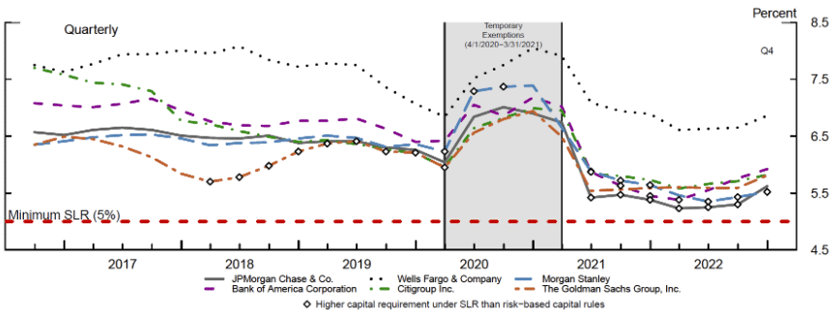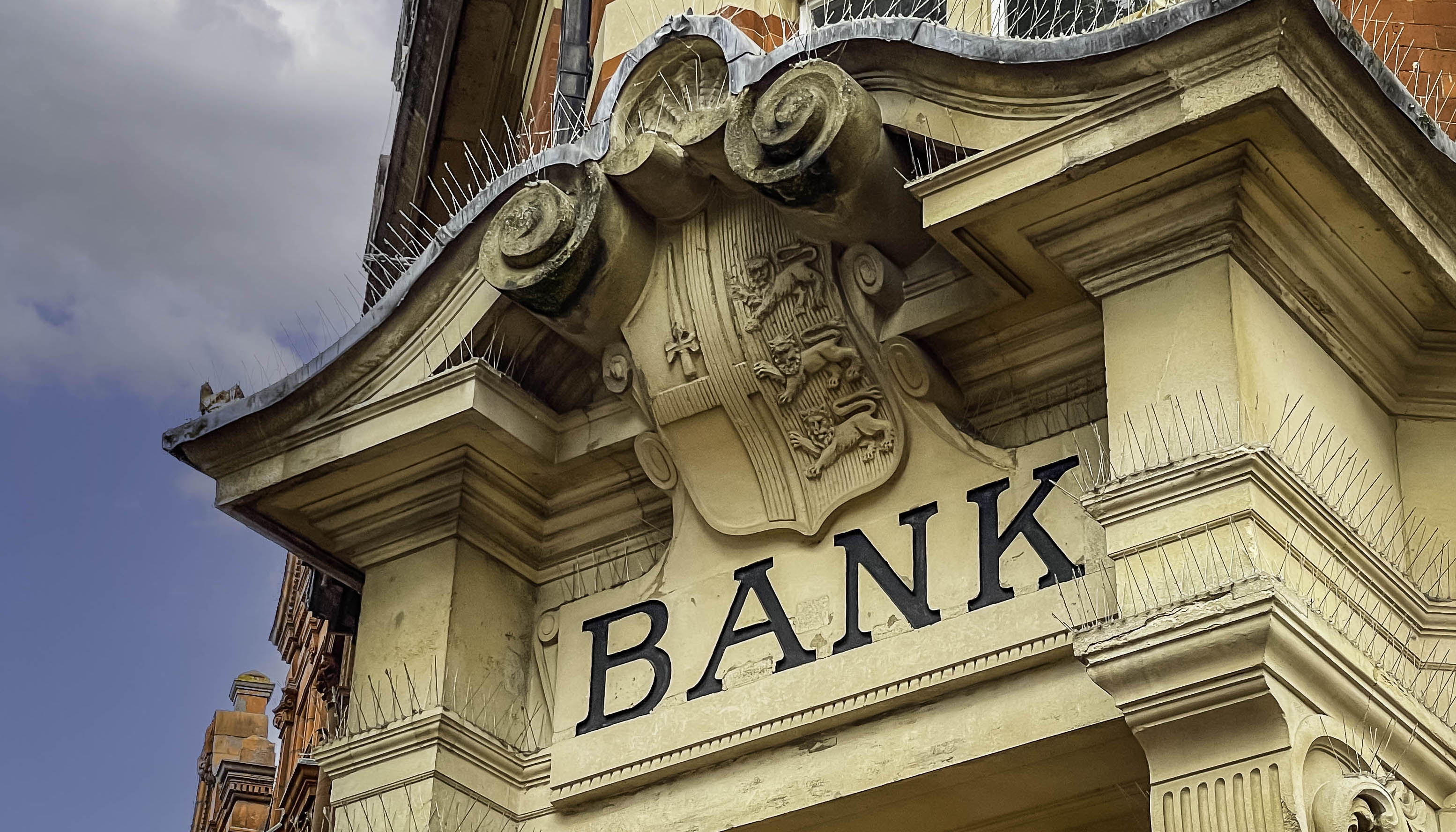Capital
Friday, May 3, 2024
By John Hintze
On April 1, 2020, amid the pandemic slowdown and deteriorating liquidity conditions in the U.S. Treasury securities market, the Federal Reserve Board changed a then two-year-old capital requirement affecting the biggest bank holding companies. The Fed excluded Treasuries and reserve deposits from the 5% minimum supplementary leverage ratio (SLR) – a banking organization's Tier 1 capital relative to its total leverage exposure (TLE) – to stimulate credit and other business activity.
The suspension of the SLR rule lasted a year, but concerns persist about the resiliency, when under duress, of the all-important, $27 trillion Treasuries market, which relies heavily on the dealer functions of those large banking institutions. The International Swaps and Derivatives Association (ISDA), for one, advocates permanently excluding Treasuries from the SLR calculation, and it contends that the issue should be addressed in the context of the so-called Basel III Endgame as well as surcharges on global systemically important banks (G-SIBs).
Bankers and their lobbyists have warned that the Basel capital proposals, if not modified, will impede lending, other intermediary activities, and ultimately economic growth. “The constraints imposed by the SLR, meanwhile, negatively affect the ability of banks to participate in markets for low-risk assets,” ISDA Chief Executive Officer Scott O’Malia wrote in a March 6 derivatiViews blog article.
Scott O’Malia, CEO, ISDA
“We think regulators should think hard about the impact of various rules in combination to ensure they achieve the policy outcomes they want,” O’Malia continued. “In this context, a permanent exclusion of U.S. Treasury securities from total leverage exposure would free capacity for banks to participate in U.S. Treasury markets and facilitate access to cleared markets, especially during periods of stress.”
Kenneth Bentsen Jr., president and CEO of the Securities Industry and Financial Markets Association, in a Bloomberg Markets interview similarly placed Basel III within a broader capital-market regulatory perspective and “how it interacts with existing prudential requirements and liquidity requirements such as things like the stress test and the global market shock. And when you put those together with this proposal, you really do impede capital markets activities of the large dealer banks.”
On the day before O’Malia’s post, ISDA argued its case for SLR reform in a 10-page letter to the Fed, Federal Deposit Insurance Corp. and Office of the Comptroller of the Currency – calling for an exclusion covering “on-balance-sheet U.S. Treasuries that a bank holds in inventory or as part of its liquidity portfolio, as well as U.S. Treasuries the bank has received in a repo-style transaction to the extent the bank records the U.S. Treasuries on its balance sheet.”
As a non-risk-weighted backstop to risk-weighted assets in banks’ Tier 1 capital requirements, according to an August 2023 FEDS Notes analysis, the SLR rule in recent years has implied a higher capital level than risk-based capital rules require. That raises the possibility “that the SLR may affect [the banks’] willingness and ability to intermediate in Treasury markets, especially during periods of increased demand for intermediation,” the Federal Reserve researchers said.

Six banks’ SLRs have been above the 5% minimum but trending down. (Source: Federal Reserve Board, FEDS Notes, August 2023)
Darrell Duffie of the Stanford University Graduate School of Business, in a paper for the Jackson Hole Symposium last August, said that since 2007, the total size of primary dealer balance sheets relative to Treasury bonds outstanding has shrunk by a factor of four.
“This trend continues because of large U.S. fiscal deficits and regulatory capital constraints, which are necessary for financial stability but reduce the flexibility of dealer balance sheets,” according to Duffie.
ISDA’s position is that “a permanent exclusion would better promote the stability and resilience of the U.S. Treasury market than the current framework, which has required adjustments during periods of significant market stress. More broadly, an exclusion would help support market liquidity in the context of projected increases in the size of the U.S. Treasury market and the importance of bank participation in the market.”
However, the FEDS Notes analysis presented data showing that the temporary exemption of Treasuries from the SLR had little impact on the big dealers’ Treasury intermediation.
“Dealers’ Treasury SFT [repo-style, or secured financing transactions] activity peaked in March 2020 but did not change significantly during the SLR exemption period,” the note said, adding that it did “not show a noticeable effect on the big six dealers’ Treasury intermediation, including direct holdings of Treasuries and SFTs backed by Treasuries.”
Marc Jarsulic, senior fellow and chief economist at the nonpartisan, liberal-leaning Center for American Progress, says that contrary to the O’Malia/ISDA argument, “SLR hasn’t inhibited the decision of banks on whether to hold Treasuries, especially in times of stress.” Instead, he adds, removing reserves or Treasury holdings from leverage requirements, without a compensating increase in equity, would make the big banks less able to absorb losses during the next big financial shock.
Marc Jarsulic, Center for American Progress
To Jarsulic, a bigger concern is the low level of equity used to finance bank activity, reflected in a current average SLR of about 6% for the U.S. G-SIBs. That “provides inadequate protection against major financial shocks,” he says. “If not for the massive intervention by the Treasury and Fed in 2008, the percentage losses at most of the largest banks would have been higher than the 6% or so where their SLRs are today.”
Jarsulic’s organization supports significantly increasing banks’ Tier 1 equity, which clashes with banking-establishment opinion, presumably to be a stronger buffer in times of market stress and enable more Treasury intermediation.
Market resiliency may be improved through transparent market-function purchase programs that activate in times of stress. That happened when the Fed stepped in to finance primary dealers’ Treasury positions as the pandemic unfolded, and then purchased Treasuries directly, according to a February 2023 Federal Reserve Bank of New York staff report by Stanford’s Duffie and Frank Keane of the New York Fed. With reduced government-securities inventories, dealers could better accommodate sellers and reduce the likelihood of fire sales and spiking Treasury rates.
“Investors would treat [such programs] as a feature of these securities, which is therefore priced into primary-auction bids, lowering the cost to taxpayers for financing government expenditures,” the paper said.
Duffie mentioned in an interview that changes in the works could bolster Treasury-market resiliency without altering SLR. One is the score used to measure G-SIBs’ systemic risk and subsequent capital surcharges. A Basel Committee on Banking Supervision consultative document proposes basing G-SIB scores on financial values averaged over the year rather than just at year-end, which has prompted rate spikes. Averaging would resolve that issue.
Another change is the Securities and Exchange Commission rule to centrally clear Treasury securities, being phased in over the next two years.
“There’s no single silver bullet that will fix this problem,” the Stanford professor said. “But those are both key features, among other things, of a more resilient Treasury market.”
•Bylaws •Code of Conduct •Privacy Notice •Terms of Use © 2024 Global Association of Risk Professionals




